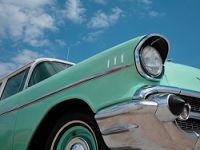
If you’re a classic car collector, you’re likely very proud of your vehicle. Whether you own one classic car or a handful, one thing remains the same for all collectors – the importance of protecting your investment.
While cars are less delicate than paintings, jewelry, or wine, they still need to be protected to preserve their condition. That’s why it’s crucial to plan for unexpected events that could cause damage to your classic car.
Consider the following checklist when you’re getting ready to store your classic vehicle(s):
- Find the right storage facility. The best off-site location for your cars, trucks, or other classic vehicles is a specialized storage facility. Unlike a restoration facility or storage unit, a professional and specialized storage facility typically has limited access to items in storage, background checks for employees, a central fire and burglar detection system, a computerized inventory system and humidity and temperature control.
- Park away from streets and driveways. Sometimes finding a professional storage facility may not be practical. In these cases, store your vehicle in a garage – parked away from a driveway or on the street. Doing so can protect the car from theft, falling trees, damage from high winds, harmful environmental conditions, and tree sap.
- Ensure garage is effectively equipped. A central fire and burglar detection system should be installed in the garage to protect the collection from theft, vandalism, and fire. Along with the central fire alarm, a fire extinguisher should be present, and all flammable materials should be stored in a protective cabinet.
- Control temperatures and humidity levels. Classic cars are often made with natural materials such as wood and leather and can be easily affected by fluctuating temperature and humidity. A stable, temperature-controlled environment can help preserve these types of cars.
- Have a portable water pump on-site for water removal. Extreme weather conditions, such as floods and high winds, can be harmful to your classic car. If any car is kept in standing water for an extended period of time it will likely result in a total loss. If your vehicle is stored in a flood prone location, make sure your garage or storage facility has flood vents to prevent pooling water.
- Assess for structural vulnerability. For earthquake prone areas, your classic car should be stored in a garage where tables, work benches, car lifts or other furniture are secured to the floor or walls.
- Protect your stored car with the right car cover. Covers can be used on vehicles stored indoors, as this is a preferable storage location. Car covers can protect a car from dust, moisture, and harmful environmental conditions. The car cover should fit tight around the vehicle and be lined with a soft fabric like fleece or flannel. Car bubbles can be used as well, but if moisture gets into the bubble, it could result in damage.
Although these tips can be helpful when it comes to storing and protecting your classic cars, make sure to work closely with your agent or broker who can provide guidance on the best insurance coverages for your treasured vehicle.
For additional information, on protecting and storing your collection, navigate to our resource page. Looking for tips on how to properly take out your classic car from storage? Learn more here.
Jessie Spigel is a Senior Risk Consultant and Fine Art & Collection Specialist.
The opinions and positions expressed are the authors’ own and not those of Chubb. The information and/ or data provided herein is for informational purposes only and is not a substitute for professional advice. Insurance coverage is subject to the language of the policies as issued.